
|   |

|   |
 e-mail: sunilkothari1933@gmail.com The 36th Natya Kala Conference: Part 1 Photos: Yoga January 3, 2017 The 36th Natya Kala Conference in Chennai was inaugurated on 26th December 2016 at Sri Krishna Gana Sabha by Vyjayanthimala. The convener of the conference for current and next year is Dr. Srinidhi Chidambaram. She received the Nritya Choodamani award in 2000. She had performed at KGS when she was 11 and her association with Krishna Gana Sabha has been for more than 30 years. She shares her views about the theme of the conference Sthiti Gati - Bharatanatyam: constant, continuous. Sthiti implies a sense of stability, rootedness and being constant. Gati symbolises movement and progress. Bharatanatyam is ancient yet modern. Archaic, yet alive. Traditional, yet an art form of today. Srinidhi has encompassed dancer and her persona, creativity and choreography, music and musicality, teaching and how artistes maintain dance-life balance –these five aspects are envisaged to be analysed and discussed in-depth, on each day of the five day conference. She has great faith in such conference for exchange of academic and scholarly views, thoughts and ideas and she is confident that at the end of it we all will be enriched. The generational mix of the participants augurs well as one looks forward to listening to the aspirations and experiences of young generation and how they would carry forward the legacy in future. 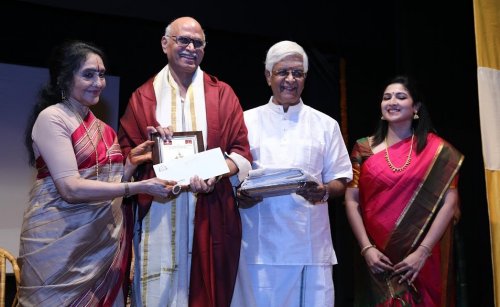
Award 'Natya Kala Visaarada ha' to Dr. Pappu Venugopal Rao
Vyjayanthimala, Dr. Rao, Y Prabhu, Srinidhi On the opening day Lakshmi Vishwanathan took us on a journey of the bygone era with her customary charm, wit, scholarly studies and excellent articulation giving us glimpse into the past. Her own study of Devadasis has equipped her with fund of knowledge. Right from Chola period to contemporary times her references were erudite, poetic and insightful. She gave examples from Silappadikaram and of the archival material of 400 dancers employed in Brihadiswara temple, with their names, the charm of devadasis, their erudition, beauty, wit, social status, ability to compose poems and perform. In those times they stopped dancing when they turned 25. They had gurus / nattuvanars who exercised control over them, so the high standards were maintained. Though roots of Bharatanatyam are traced in Natyasastra, she emphasised that there is a special Tamil heritage of Thanjavur. Madhavi of Silappadikaram was a courtesan par excellence. Fatally attractive, she was in a class of her own. Lakshmi referred to 16 upacharas, explained what bhakti meant, passion, and covered centuries in nutshell. She spoke of Vijayanagar Empire, of Nayak period, the glory, later of Marathas, the Tanjore Quartet who composed Margam, the poets who evoked feminine feelings in their poems, of poet Kshetrayya and his shringara laden poems, some devadasis like Manikyamma, performances of devadasis of Tiruvarur, devotion to Tyagesha, of chinna melam and periya melam, of their status, of dancers who performed in 1930s and of their achievements, versatile accomplishments, of soirees in Georgetown (in Chennai), of veena playing and classical music. "Danike" varnam was composed for Shivaji Maharaj, Kamukannama wore khadi only to align with freedom movement, of zamindars, patrons, and Muthulakshmi bringing a bill for not performing dance - quite a bird's eye-view. She spoke in great style and created an engaging picture of bygone era. Lakshmi observed that there is no bringing back anything. People change, attitudes change, bodies change. Tradition gets transformed but it can be informed by pure knowledge. The wisdom of knowing what you are teaching and what one is learning is a fine balance. It should be the goal of every true artist. Yes, it is elusive, it cannot be denied that this art is vital to our culture and there is a need to carry on tradition. 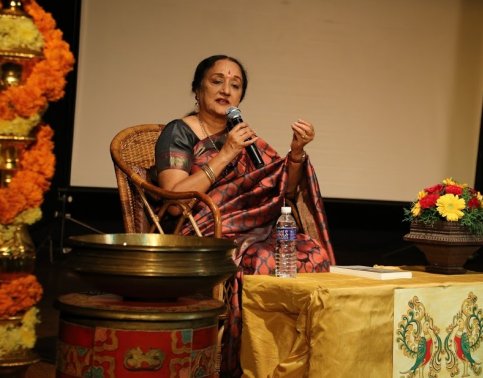 Lakshmi Vishwanathan 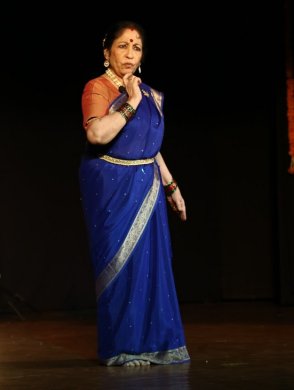 Revathi Sankkaran Revathi Sankkaran spoke on classical dance moving to celluloid. She is an actor par excellence, witty, saying things on your face, making fun, mimicking and bringing alive how the classical Bharatanatyam dance moved to silent films and then to talkies. She spoke of Kattumanarkoil Muthukumara Pillai, Vazhuvoor Ramaiah Pillai, who taught Baby Kamala dance and her dance in films, its abiding impact when all mothers wanted their daughters to dance like baby Kamala, early dancing which was limited, not refined. The dancers who had given up dancing were brought to celluloid, as film producers engaged them for dance, but dancers like Laitha, Padmini, EV Saroja, Bhanumati, Hemamalini Arni, Sayee and Subbulakshmi, and of course Vyjayanthimala, are still remembered. She mimicked also movements and was a riot. Some clippings were screened to give an idea of Bharatanatyam dance in films. They were hilarious, comic, diluted. But some of Padmini and finally on Vyjayanthimala in 'Nai Duniya' (?) where she performed Alarippu was unforgettable. That clip won rounds of applause for her exquisite classical movements. Revathi's session had the audience in splits. The audience thoroughly enjoyed it and had an idea of how Bharatanatyam was used earlier in films. 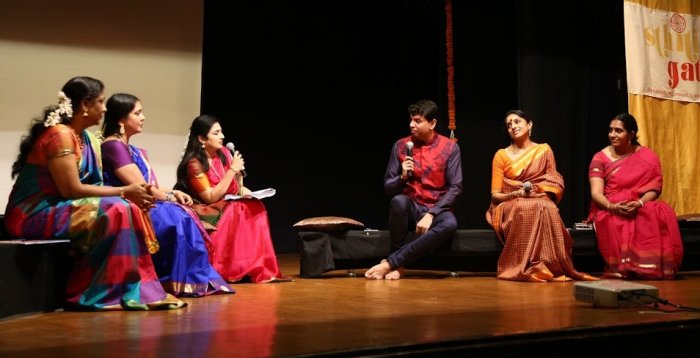
Panel
The dancer of today, a panel discussion by Aniruddha Knight, Narthaki Nataraj, Gayatri, Krishnaveni Lakshman, Meenakshi Srinivasan, Uma Namboodripad Sathyanarayanan, moderated by Srinidhi gave voice to the dilemmas and challenges the young generation is facing. Srinidhi outlined how each dancer of today has to multi-task so many things: practice, learn from guru, later on teach, after marriage balance life and career as a dancer, if following anther parallel career, as in her own case as a doctor and a dancer. Meenakshi Srinivasan is an architect too - how to manage rehearsals, do publicity, let sabha secretaries know of their performances, getting shows, costumes, travels and what have you. Yet they are passionate about it. In case of male dancer like Aniruddha Knight, grandson of legendary Balasaraswati, the responsibilities of carrying on tradition, be true to it, maintaining integrity, keep pace with changing times and still be creative were issues of concern and as dictum each one to one's own self, he acknowledged the responsibility and burden of legacy. Narthaki Nataraj faced several issues as a third gender dancer but overcame it with dedication, determination, following the great tradition. She studied under Kittappa Pillai and has earned recognition from institutions like Sangeet Natak Akademi. She emphasised that we may laugh at old forms of art, the calmness and peace they bring to us could look outdated, but we have to respect the fact that they have survived hundreds of years. It is not easy to create something new that will similarly stay alive even after 1000 years. We often see what is new and modern is short lived. It is important to make young generation understand this critical aspect. We have to train them to document and learn, recreate and preserve old traditions, then we can ensure that our art forms will remain alive even after many years. The young generation has to learn this. Gayatri agreed that dancers need many more skills than their dance. She was lucky to be born in a family where her mother Krishnaveni was performing for Rukmini Devi's Kalakshetra and dance came to her from her mother. Her personal story seemed to have advantages. She too agreed that teaching dance sharpened her understanding of dance. Meenakshi Srinivasan has to practice every day to be a dancer, but not to be an architect. However both have helped her as they have co-existed in her life, and are creative arts complementing each other. She believes in inter-personal skills and beliefs to manage her time both for dance and architecture. Uma Namboodripad had come from a small village but learning dance under Chitra Visweswaran changed her life and multitasking is a must for a present day dancer. Posing questions, Srinidhi succeeded in making dancers reflect upon challenges they have to meet. 2nd Day It was heartening to witness a large audience of young dancers filling up the hall to listen to stalwarts like Alarmel Valli, Padma Subrahmanyam and the Dhananjayans. Alarmel Valli's journey as a dancer has been exceptional. Music, poetry and movement have been inextricably woven in her world of dance. From childhood she has been soaked into poetry, training in dance under Chokkalingam Pillai and his son Subbaraya Pillai, learning music from T. Mukthamma and vast literature she had access to thanks to her maternal grandfather's library. But more than that, it was her own responses to decisive moments of watching Balasaraswati on two occasions left great impact on her understanding of dance. When Bala enacted minimally by lifting her eyes to show how in Vamana avatara lifting her eyes upwards she created minimally the great form the lord took and touched the sky, and another when Bala said that abhinaya cannot be taught, the body listens to the music. She quoted choreographer George Balanchine who called dance "visual poetry" and German critic Eduard Hanslick's observation that "music is form moving in sounds." She realized that by the same token dance could be seen as sound moving in forms. She spoke of 'visual music' and 'audible dance.' An excerpt of her recital with Bombay Jayashree singing for her in 'See the music and hear the dance' was screened. A deep understanding of these elements informs Valli's art. She spoke of use of metaphors for sanchari bhavas. The storehouse of imagination one acquires through poetry brings such richness and dance becomes layered. She laments that today musicians have no time and it is rare someone like Bombay Jayashree came for twenty rehearsals with her. Dancers have no time to read poems, to soak in music or reflect and present scenario is not conducive to dancers to acquire the quintessential qualities which they internalize and draw upon. She agreed that Margam format is complex but has an ability to be elastic. And is capable of handling complexities. A clipping of Kshetragna's padam 'Payyada' was screened that showed how nayika's cry was for her desolation when her beloved had moved away! The tones, colours, modulations et al were referred to and she concluded with reading Arundhati Subramaniam's poem 'Vigil' with intonations reflecting the music and visuals which left an indelible impression. Valli's session was thought provoking and there was a lot that the young dancers could learn from. 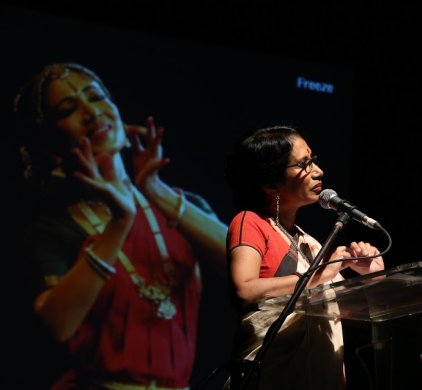 Alarmel Valli 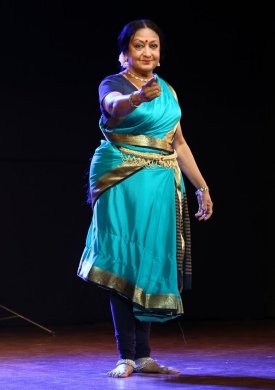 Padma Subrahmanyam Padma Subrahmanyam's anxiety to study theory from her young age led her to discovery of various gaps between practice and theory. Her path breaking work of Bharatanrityam is well known and her scholarship is overwhelming. Her creations of ekartha solo works like 'Krishnaya Tubhyam Namah' and 'Ramaya Tubhyam Namah' as uparupaka Bhan/Bhanika are even today in demand which she performs with her usual virtuosity, investing the work with creativity. Rukmini writing letter to Krishna 'Shrutva bhuvan gunan sundara' and addressing Krishna as Achyuta, in various ways, with unforgettable melodious singing by Shyamala Balakrishnan evoked nostalgia. From Kamba Ramayana when Rama looks at Sita and Sita at Rama 'Avanum nokkinan' have remained her signature touches. V.A.K. Ranga Rao requested her to demonstrate Valitoru karana which she did but before that she mentioned that he had earlier criticised it for looking like cabaret dance, using her hips in a manner as seen in films. Padma had answered that it was cabaret dancer who was imitating her, not she! She was recreating movement from sculptures and karanas as mentioned in Natyasastra and Abhinavagupta in his commentary. Padma's contribution has been significant and she said that her disciples follow her pedagogy. She quoted Gandhiji saying, let winds come from all directions but they shall not uproot me. Her deep faith in rootedness in dance has been a lesson for the young generation. The Dhananjayans regaled audience with clippings of group choreography and their approach. Working with Ohio Ballet for Jungle Book production with ballet dancers and with music composed by Vijayraghav Rao and collaboration with western musicians were not only creative but also historic. Their own training in Kalakshetra, taking part in group choreography of Rukmini Devi and an ability to remain alert to all performers were emphasized. On special training for male dancers and how he could also impersonate woman's abhinaya, Dhananjayan demonstrated to an appreciative gathering, with the young generation of audience in splits. The opportunity to see seniors in such welcoming frame of mind to explain their journeys in dance was a highlight of the morning sessions. Srinidhi and her collaboration with Akhila Krishnamurty and team of Alaap, who coined the word Sthiti Gati, indeed succeeded in roping in a galaxy of senior dancers, which was praiseworthy and indeed set apart the present conference from earlier conferences. The response of young dancers has been a sign of change in the profile of the audience. 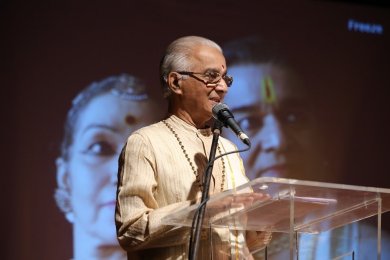 VP Dhananjayan 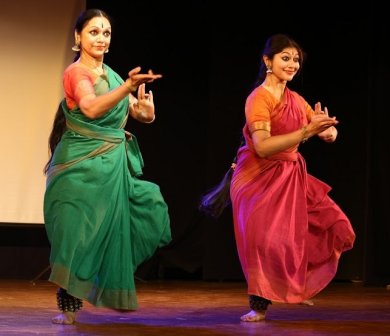 Rama & Dakshina
3rd Day The session opened with Rama Vaidyanathan's presentation of how living in the North she has been reaching out to audiences with Bharatanatyam. Rama has adopted lyrics from Brijbhasha/Hindi which are understood by the audiences. The pada on receiving Hari, with various images of monsoon, raindrops falling, nayika listening to the flute and about Krishna's arrival, was performed to explain how with Hindi language the form of Bharatanatyam is made accessible. And for international audiences, to wit, World Music Festival in New York, she chose Sangam poetry delineating relationship between mother and daughter. It was performed with her own daughter Dakshina. When the daughter grows up and has a relationship with lover of her own choice, the mother starts feeling insecure, as the daughter will move away from her. Taking various metaphors, the mother reconciles to daughter's moving away. The sandal wood on mountain needs to be cut for the fragrance to spread everywhere; the pearl has to be removed from the oyster to be used as an ornament; the seven notes emerge when strings are plucked from a veena. Similarly, the daughter has to leave the mother and has to be released. But they remain close to each other. Rama used images of cutting umbilical cord and the release of daughter. Playing with a ball, between mother and daughter, the image of closeness was suggested. The relationship as depicted by Rama and Dakshina had an instant appeal to the audience and was easily understood by audiences abroad. The selection of lyrics thus makes the art of Bharatanatyam accessible to any audience by a thinking dancer. The audience at the conference responded instantly. Convener Srinidhi mentioned that her eyes were moist as watching the performance she thought of her own daughter, when she would get married and leave her. The panel discussion on 'Music, Music Composition and Lyrics' was moderated by Lalgudi GJR Krishnan. Vocalist and musician S. Rajeswari, mridangist Nellai D Kannan, dancer, choreographer and music composer Madurai R Muralidaran, vocalist Radha Badri and music composer Rajkumar Bharati spoke of their personal experiences and growth and how they have dealt with music and dance. Rajeswari recalled the gambhir intonations of Vazhuvoor Ramaiah Pillai, his recitation of sollus and the tonal variations, Kittappa's extraordinary musical richness, Adyar Lakshman's understanding of rhythm, exquisite rendition of Shyamala Balakrishnan's 'Achyutam' and the variations for that one name of Lord Krishna and Padma's abhinaya. She had sung for Kamala and the perfect understanding of the music and dance, going hand in hand she valued the most. She remembered the singing of Charukesi varnam and Bhavayami varnam for Kamala, viruttams, singing of "Varugalamo" and the intense feeling invested in its rendering. Rajkumar Bharati spoke of musical translation of rasa to be conveyed by the music composer. The vital point in music to be remembered is translation of ideas, the inherent understanding of words and to bring out its nuances, to remain protector of authenticity and be original and imaginative. He said that the process of composing music allows him an opportunity to study himself and not other minds. For him it is a great spiritual learning. He just listens to the situation for which the music is to be composed and some lyrics are to be tuned, and what a dancer wants him to convey. He respects it and composes the music for dance. He also referred to orchestration of music and need for thematic presentation where recorded music is required. 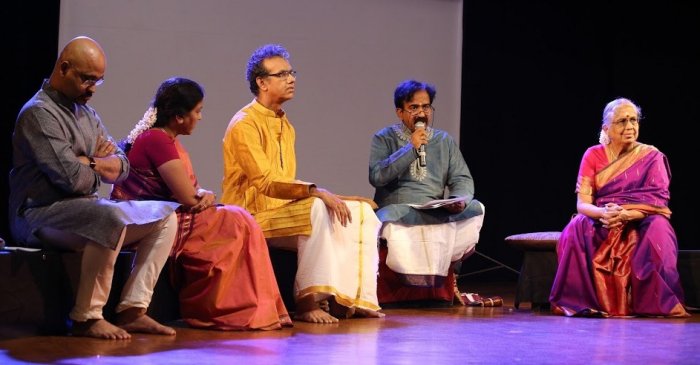 Panel Radha Badri is a celebrated name as dance vocalist and several leading dancers have had the benefit of her availability even at the last minute. That speaks volumes for her versatility. For young generation of musicians she advises that they need to work very hard. Singing for dancers, they need not show off but follow the dancer and highlight the dance. Singing for dance is an art and mutual respect needs to be appreciated. The originality of song must not be changed else one would not know what the original song was like. Too much improvisation also should be avoided. Lalgudi GJR Krishnan observed that for composing music for dance one has to be mindful that the composition is to be used for dance. The dancer must have some space and the music cannot be all packed up. The prime objective of the musician should be to bring out the best in the dancer and not to challenge her. The music should inspire the dancer. Like his late father the great violinist Lalgudi Jayaraman, he would advise all young musicians to be open to feedback from dancers, and also flexible. The dance is the medium and music must give them freedom to explore and not become a limitation for them. It was a very stimulating session to listen to these stalwarts who spoke with great concern for music for dance. The session by Anita Ratnam offered the young generation of dancers and, in particular, the Diaspora dancers several hints and advice. Widely travelled and exposed to best of performing arts within India and abroad, participating in international conferences and genuinely concerned about art of dance she spoke frankly concentrating on what she called ecology of dance. Her stay abroad and experience has equipped her to think about the several issues which Indian Diaspora dancers face abroad and what dancers from within India wanting to perform abroad. The reality of global Bharatanatyam and the present preference for Odissi and Kathak and the wrong impression dancers have that Bharatanatyam is most popular, were clarified by her. She mentioned why good notes be prepared to avoid use of words like sacred and divine and spiritual. In UK and USA, writing for grants is a special art and after receiving grant its assessment is also transparent and most important. She emphasised the role of a dramaturg, a mentor, lights designer, art of presentation, need to adjust taking spaces into account. She lamented absence of excellent theatres in Chennai, and urged dancers to feel the absolute need for the same. When Government is giving crores of rupees to institutions like SNA and its constituent bodies like Kathak Kendra, Jawaharlal Manipuri Dance Academy, Kuttiyttam Kendra, Sattriya Kendra, the awareness for requirements of theatres, spaces for rehearsals etc., are not yet understood. Also the corporate sector does not realise its responsibility to assist efforts for physical spaces necessary for dance, its creation, production and related matters. She gave statistics and regretted that dancers and artists have not understood that they must make demand to change the situation. Anita also spoke of choice of themes for presentation. Giving example of last year's floods in Chennai and the devastation caused at that time, to perform jalakrida themes was incongruent. Her advice to the young generation was to be observant, aware of situations, of politics, if the reviews in foreign newspapers carry mistakes and wrong references, why we must send letter to correct wrong information. Of late New York Times dance critics cover Indian dance performances and lot of space is given in media for Indian dance, so the USA audiences are inclined to watch Indian dance. 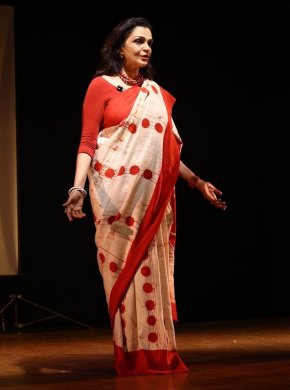 Anita Ratnam 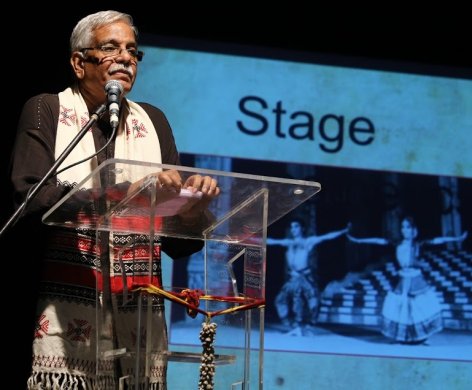 V.V.Ramani The final session saw V.V. Ramani, artist, stage and costume designer, taking audience to the personal journey of his collaborations with dancers, organizers, for stage designing and how he has succeeded in creating awareness about aesthetics, visuals which help dance, in terms of its appeal and artistic values. The series of photographs he screened were interesting and outlined the changes that one sees of late, though a lot needs to be done. It was heartening to see that organizers and few sabhas and secretaries have collaborated with him and benefited, as well as few dancers who have sought his assistance. He maintains that today people are exposed to and are familiar with what best the world has to offer. Earlier in olden days temples provided artistic settings. Today artists themselves have to be alert and improve their presentations.  Dr. Sunil Kothari is a dance historian, scholar, author and critic. He is honored with Padma Shri, Sangeet Natak Akademi award and Senior Critic Award from Dance Critics Association, NYC. Post your comments Please provide your name and email id when you use the Anonymous profile in the blog to post a comment. All appropriate comments posted with name & email id in the blog will also be featured in the site. |